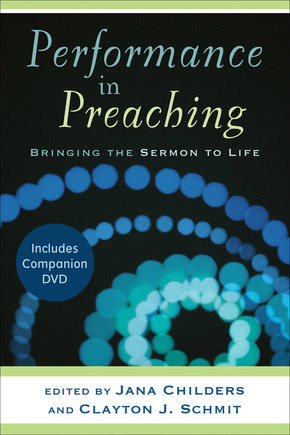Performance in Preaching
 Jana Childers and Clayton J. Schmit, eds., Performance in Preaching: Bringing the Sermon to Life (Baker Academic, 2008), 256 pages, ISBN 9780801036132.
Jana Childers and Clayton J. Schmit, eds., Performance in Preaching: Bringing the Sermon to Life (Baker Academic, 2008), 256 pages, ISBN 9780801036132.
While whole libraries of books have been written on the preparation of sermons, the art of successfully delivering them is much less studied. In this collection of articles, leading scholars on the performance aspect of preaching give us a welcome insight into not only the things preachers can learn from other performers but also what it means to examine preaching in this light.
From the first lines of the introduction, it is clear that we are not in the well-trodden territory of traditional preaching manuals. By comparing the variety found in preaching to that found in a circus, Childers and Schmidt make it clear that the emphasis in this volume will not be in making all preachers alike but in alerting them to ways of building greater self-awareness and improving their skills.
All this talk of circuses and performance might make us wary that preaching will be relegated to the status of entertainment and lose its power (cf. 1 Corinthians 2: 1-5). It is with this in mind that we should read Margaret Shuster’s essay entitled “The Truth and Truthfulness.” While outlining the importance of the spoken and listening aspects of preaching, Shuster is keen to stress that the primary role of a preacher is not that of a performer but that of a proclaimer of Truth. Performance is therefore the servant of the text and the preacher is above all a servant of God.
John M. Rottman’s discussion of the application of Speech Act theory to preaching reminds us of the limitations of using the tools of performance studies. God does, after all, work mightily through sermons that fail to fulfil the criteria we might set up for good preaching. Nevertheless, Dr Rottman is still keen for us to learn what we can from performance studies while still remembering that God is the senior partner in our preaching.
This partnership does, of course, include our responsibility to ensure that our delivery does not hamper the work of God in the congregation. This concern is reflected in several of the articles in this book, such as Todd Farley’s insightful chapter on movement and Richard F. Ward’s essay on the use of the voice. Both of these pieces contain useful ideas on improving the connection between what we say in the pulpit and how we say it.
The wonder of preaching: God chooses to reveal Himself through our words and not because of the skills we might possess.
In a similar vein, Alyson M. Mackenzie’s examination of the New Homiletics, which insists on the importance of the delivery of sermons, can be read as a useful bridge between the theological discussions of performing a sermon and their practical application. Given her perspective, it is no accident that this article contains a range of thoughts and questions that will guide preachers towards more effective delivery.
Category: Ministry, Winter 2011


